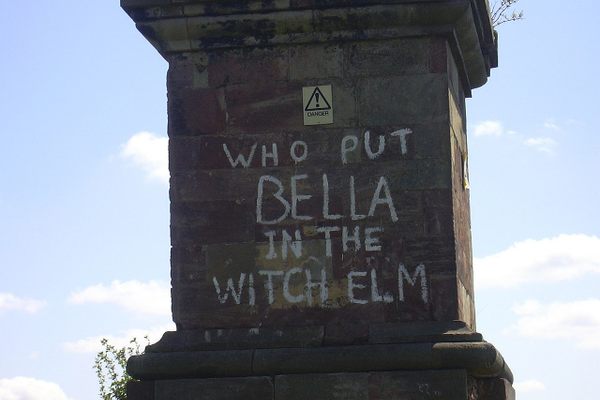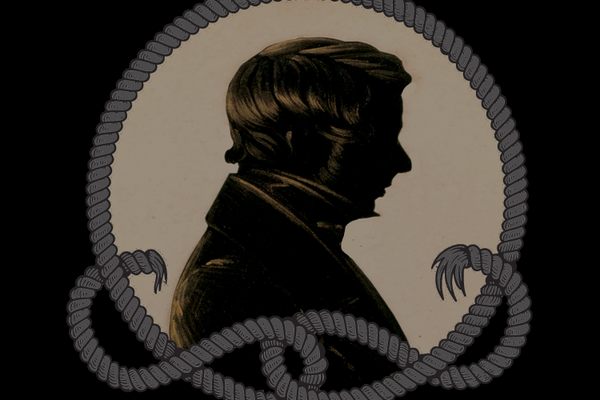Who Put Bella In the Witch Elm?
31 Days of Halloween: On Atlas Obscura this month, we’re celebrating Halloween each day with woeful, wondrous, and wickedly macabre tales all linked to a real locale that you can visit, if you dare.
 Wychbury Obelisk in 2006 (photograph by David Buttery)
Wychbury Obelisk in 2006 (photograph by David Buttery)
In wartime England, four teenaged boys were hunting for rabbits and bird eggs in Hagley Wood, on the outskirts of Birmingham, when they found what they thought was an animal skull inside a hollow witch hazel tree. There was a bottle in there too, and a pair of ladies’ shoes.
When they pulled the items out, they discovered that the skull had human teeth and hair and was probably not an animal’s skull after all, whereupon they showed it to one of the boys’ older brothers. Then they decided that they weren’t really supposed to be on the property in the first place, so they put everything back in the tree trunk and went on their merry ways without mentioning it to anyone else.
The skull found in the tree (Public Domain)
Only one of the boys, the youngest, told his parents, who phoned the police. When the skull was again retrieved from the tree, a skeleton was also exhumed, along with a few more personal items—all of which were found to have belonged to a petite, middle-aged woman who’d given birth at least once. She had dark hair, distinctly irregular teeth, and a wad of taffeta stuffed in her throat. She was missing a hand and a “shine” [sic] bone; these were found buried next to the tree. She’d been dead for at least a year and a half.
It was 1943 and World War II was in full swing, which meant there was a huge uptick of reports being filed on missing persons in Europe. The police suspected the woman was foreign, possibly German or Dutch, based on the items found with her body and the fact that no one matching the description had been reported as missing anywhere near Hagley Wood. Dental records were combed exhaustively without a match. But with a war’s worth of missing women to choose from and not a lot to identify this one by, the case soon grew cold.

Wychbury Obelisk tagged in 2002 (photograph by Simon Norman)
Around two years later, near Christmas of 1944, graffiti appeared on an empty building in the West Midlands town of Old Hill that asked, in three-inch letters: WHO PUT LUEBELLA DOWN THE WYCH-ELM. (Witch elms and witch hazels are commonly mistaken for one another.) Variations on the theme soon appeared in and around the Midlands, usually including the name Luebella or Bella and the words Hagley Wood. Sometimes it just said HAGLEY WOOD BELLA. After a few weeks, the phrases homogenized into a consistent one: WHO PUT BELLA IN THE WYCH [sometimes WITCH] ELM. All graffiti seemed to be written in the same hand: block letters in white chalk.
If the graffiti artist had a lead on the corpse’s identity, he or she never contacted the authorities with it. But the lady now had a name, whether it was correct or not, and the locals—including the police—adopted it.

Graffiti in 2013 (photograph by mjeshenton/Flickr user)
Theories about Bella swirled over the years. Some said she was a rape victim; some said she was an ostracized gypsy woman. Some called her a prostitute. The severed hand was said to refer to “The Hand of Glory,” a black magic ritual that transfers the power of a dead criminal to the living. To complement this idea, it was pointed out that the spirit of a witch supposedly can be imprisoned if her body is placed in a hollow tree.
A spy ring was definitely operating in the Midlands during the Birmingham Blitz and a woman named Clarabella Dronkers, who was about 30 and had irregular teeth, was allegedly the wife of a known Dutch spy. A 35-year-old German cabaret actress named Clara Bauerle, which sounds kind of like “Bella,” was involved with the Nazi espionage scene and had disappeared in 1941 or so, and her teeth were unusual too. Among this was, of course, no evidence that Bella was even the lady’s name. It could have just be an affectionate epithet coined by the graffiti’s author.
The woman in the witch hazel was never concretely identified, nor was the situation surrounding her murder. (The tree has also since died.) The graffiti, however, outlived everybody — it continued popping up throughout the English Midlands for years and years, particularly recurring in white spray paint on the 200-year-old Wychbury Obelisk in Birmingham, reading WHO PUT BELLA IN THE WITCH ELM. Like the woman found in the tree, no identity has ever been revealed for the artist.

View of the obelisk on Wychbury Hill (photograph by Trevor Birch)
WHO PUT BELLA IN THE WYCH ELM: WYCHBURY OBELISK, Hagley, England
Click here for more of our 31 Days of Halloween, where each day we’re celebrating the strange-but-true unsettling corners of the world.











Follow us on Twitter to get the latest on the world's hidden wonders.
Like us on Facebook to get the latest on the world's hidden wonders.
Follow us on Twitter Like us on Facebook